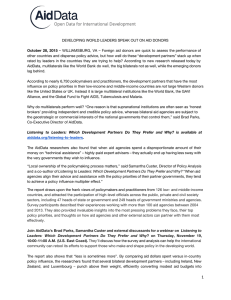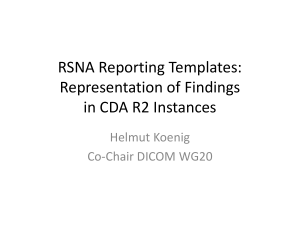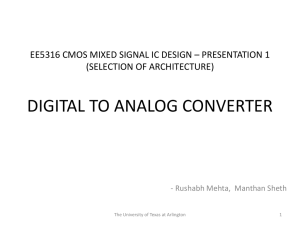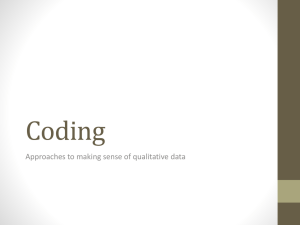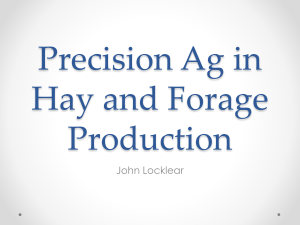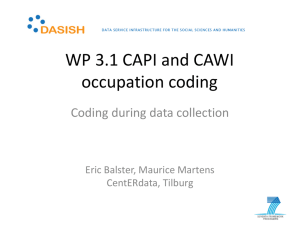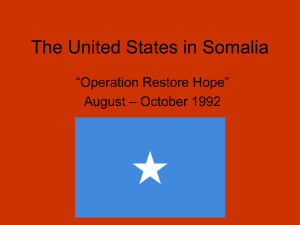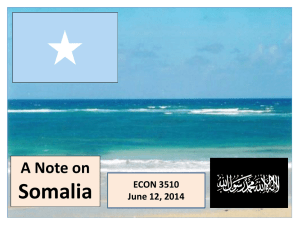Aid Locations during Civil Wars South of the Sahara The UCDP and
advertisement
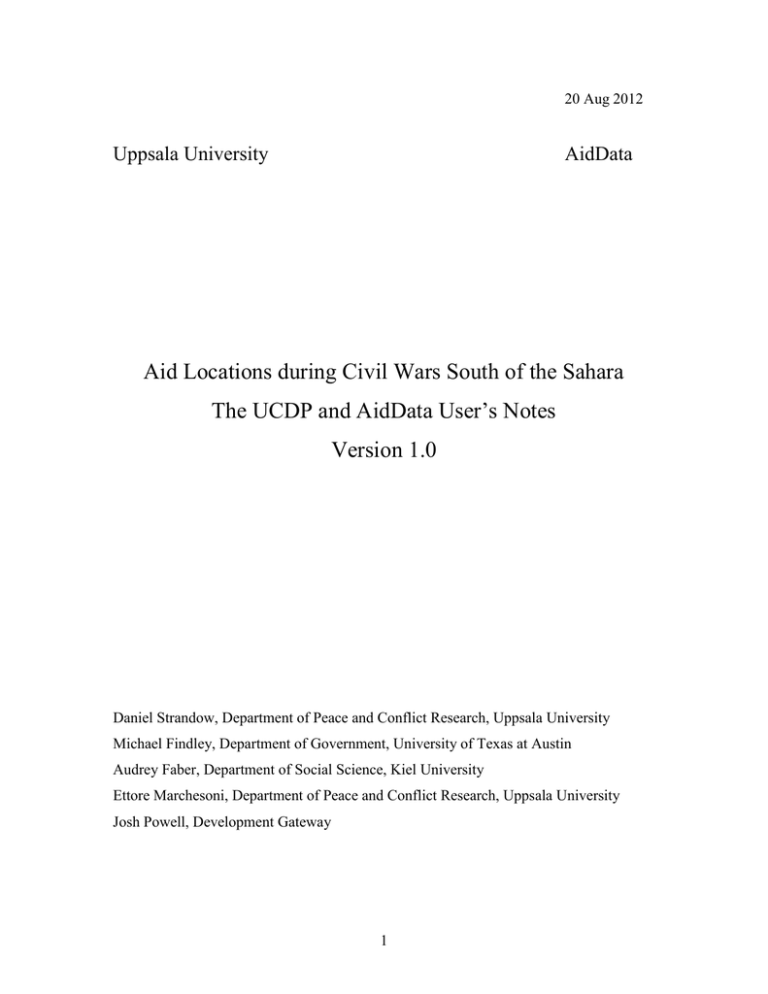
20 Aug 2012 Uppsala University AidData Aid Locations during Civil Wars South of the Sahara The UCDP and AidData User’s Notes Version 1.0 Daniel Strandow, Department of Peace and Conflict Research, Uppsala University Michael Findley, Department of Government, University of Texas at Austin Audrey Faber, Department of Social Science, Kiel University Ettore Marchesoni, Department of Peace and Conflict Research, Uppsala University Josh Powell, Development Gateway 1 Introduction The aim of these user’s notes is to facilitate the use of the Uppsala Conflict Data Program (UCDP) and AidData dataset “Aid Locations during Civil Wars South of the Sahara”. To understand these particular data, users should consult two documents: Version 1.0 (this one) and Version 1.1, which can be found through UCDP here and which we refer to below. Whereas the V 1.0 user’s notes describes a particular dataset – the first dataset of foreign aid geocodes from the AidData portal – the V 1.1 document describes the UCDP/AidData approach to georeferencing generically. This 1.0 document describes the spatial and temporal domain of the dataset, variable names, differences between this and the generic version of the aid georeferencing codebook (V 1.1), and clarifies some casespecific coding decisions. A note on the two versions may help explain why we are releasing these V 1.0 notes along with the V 1.1 codebook. After we began georeferencing aid projects from the AidData portal for the 1.0 dataset, interest quickly arose elsewhere to georeference aid based on full-length project documents. Thus, while we were still in the process of coding Version 1.0 (the dataset released here), we also worked together with AidData, the World Bank, and others to georeference additional aid projects. In that process, we published a generic version of the codebook (V 1.1) through the UCDP Paper Series (link here). The World Bank’s coding procedures are based almost completely on V 1.1 with some minor exceptions (see here). This 1.0 manual proceeds with some basic information on the dataset and moves on through the specific spatial variables and the differences between V 1.0 and V 1.1. In conjunction with this, the other variables from AidData are also presented. Following this related publications and websites are listed to further facilitate the use of this and related datasets. 2 Time Period and Spatial Boundaries To enter the dataset a country in Sub-Saharan Africa needs to have experienced at least one year of intra-state conflict since the start of 1989. To experience intra-state conflict means that there have been 25 annual deaths, or more, in violence between at least one organized group and the government. The thresholds and year ranges are based on standards adopted by UCDP. Once a country has entered the dataset, the years where organized non-state groups battle each other are also coded. A country remains in the dataset for every first year after a year of intra-state conflict, or non-state violence. After spells of inactivity a country can always enter the dataset again. A country in which a conflict starts after 2007 is not included. For the cases that are included in the dataset, 2008 is the last year that is coded. The geographic extent of what is here called Sub-Saharan Africa includes a couple of cases that are sometimes not considered a part of Sub-Saharan Africa, and lacks a couple of candidates. The list below for example includes Sudan but excludes Mali. We describe below which countries and year ranges we have covered. Figure 1 Countries South of the Sahara with Active Conflicts 1989–2008 Country State-based Additional Post- conflict years Organized conflict non-state year conflict years Angola Burundi 1989–1995, .. 1996, 1998–2002 2003 1991–92, 1994– 1991–92, 1993 2006, 2008 1994–2006, 2008 Central African 2001–2002, .. 2003, 3 Comment Republic 2006, (2009– 2007 2010) Chad 1989–1994, .. 1995, 1997–2002, 2008 also coded 2003 2005–2010 Comoros 1989, 1997 1998 1990 Islands 1999 has not been coded although it is a post-nonstate year Congo, 1996–2001, Democratic 2006–2008 2002–2004 2005 Note that 2005 is postnon-state year Republic Congo, 1993–1994, Republic of 1997–1999, 2000, 2002 2003 Djibouti 1991–1994, .. 1995, .. 1999 1995, Versus Eritrea 2008 not 2000 coded since it is an interstate conflict Eritrea 1997, 1999, .. 2003 1998, Djibouti versus Eritrea 2000, 2008, and versus 2004 Ethiopia (1998– 2000) intermittent year 2001 not included since those are interstate conflict years Ethiopia 1989–1996, .. 1997 1998–2008 Guinea Bissau 1998–1999 .. 2000 Guinea 2000–2001 .. 2002 2002–2004 2005 .. (Conacry) Ivory Coast 2006 has not been coded since it is a post-conflict 4 year of a non-state dyad that wasn’t coded as such by the time we did our coding Lesotho 1998 .. 1999 Liberia 1989–1990, 1991–1992, 1993, 2000–2003 1994–1996 1997, 2004 Mozambique 1989–1992 .. 1993 Nigeria 2004 (2009) 2003–2004 2005 (2008) Conflict year 1996 (Cameroon vs Nigeria) is not coded Rwanda 1990–1994, .. 1997–2002, 1995, Includes only two events 2003 from 1995 (2009–2010) Sierra Leone 1991–2000 .. 2001 Somalia 1989–1996, 1997–2000, .. 2001–2002, 2003–2005 1998–2000 are missing since non-state prior to 2002 weren’t available 2006–2010 when we started coding Sudan All years .. .. Note that South Sudan was considered a part of Sudan by the time the area was coded Uganda 1989–1992, 1995–1997, 1994–(2010) 2003, 2004 5 1993 AidData Variables Below is a shortlist of the names of the AidData variables that have been included with this data release. For a full description see the AidData codebook version 1.6 and 2.0. Figure 2 Variable Names and Contents Name Content Comment project id Unique identification number rname Name of the recipient country recipient_id Numeric identifier of the recipient dname Name of the donor state or organization donor_id Numeric identifier of the donor year The year that the aid project was committed comtorig Size of the commitment in This value is for all the original currency locations within a project. To arrive at an average per location divide the value over numbloc (see figure 3) origtyp Type of original currency usdcr Size of commitment in This value is for all current US dollars locations within a project. To arrive at an average per location divide the value over numbloc (see figure 3) 6 usdco Size of commitment in This value is for all constant (2000) US dollars locations within a project. To arrive at an average per location divide the value over numbloc (see figure 3) crspcode The OECD Creditor This code is also used for Reporting System code that most non-CRS projects describes the type of activities that the project supports src Source of the AidData variables data_source_id Identification number of the source oecd_id The OECD identification Only available for project number information available from the Creditor Reporting System 7 UCDP and AidData Spatial Variables The following variables are the result of the cooperation between AidData and the Uppsala Conflict Data Program. For a full description see the UCDP and AidData codebook on Georeferencing Aid, V 1.1 (2011). Figure 3 Variable Names and Contents Name Content Comment event id Within an aid project each location that This id is constructed based on receives aid gets an event id. the project id and has two decimals. For instance location one in project 635 is 635,01 lat Coordinates that express the latitude of If events only have a location with up to six decimals information on the administrative division, and long Coordinates that express the longitude not the exact location, then the of a location with up to six decimals centroid point of the administrative division is recorded precision For each set of coordinates, the The nominal scale have values precision of the geo-referencing is between 1 (exact location or specified city) and 8 (aid to central government) ADM1 Specifies the name of the first-order String administrative division ADM2 Specifies the name of the second order String administrative division loctext A comment from the coder(s) String – this typically includes concerning the project location the location name and any 8 notes of why the location was georeferenced numbloc The number of locations that a project Numeric reaches Differences in Content between the 1.0 Dataset and the 1.1 Codebook Sources for Coordinates The 1.1 codebook specifies Geonames as the main source for finding coordinates, and has the NGA GNS as a complementary source. In the 1.0 dataset it is the NGA GNS that is the main source and Geonames that is the complementary source.1 Statoids.com has been added as a source for the coding based on the 1.1 codebook but it has only been consulted sparingly in this dataset. Roads and Other Lines According to the 1.1 codebook if a source specifies a stretch of road which receives funding, then the coder should record all towns that are explicitly mentioned in the source and that connect the road, as well as any provinces through which the road passes. The difference to the 1.0 dataset is that in the dataset no provinces through which the road passes are recorded. 1 The only exception is Chad which is coded with the most recent method. The two sources are however similar enough that there should be no substantial and systematic deviations from the coding done on the other countries. 9 Areas Greater than an ADM1 When areas greater than an ADM1 are coded with precision code 5, the 1.1 codebook says that the ADM1 field should be left blank and that each province containing a portion of that geographic feature (such as a National Park or Ecological Reserve) should receive a separate code. However, in the 1.0 dataset the administrative regions contained within a greater region is normally not coded – only the greater region is coded. Although the most recent method provides greater potential to capture details, for many uses of the dataset the difference between the two methods will not be substantial. 10 Related Publications and Websites African Development Bank Geocoded Dataset (2009-2011 Projects): http://aiddata.org/weceem_uploads/_ROOT/File/geocoding/AfDB_2009_2010_AllApproved Projects.zip African Development Bank 2011 Annual Development Effectiveness Review: http://www.afdb.org/fileadmin/uploads/afdb/Documents/Project-andOperations/ADER%20(En)%20-%20Websafe.pdf African Development Bank 2012 Annual Development Effectiveness Review: http://www.afdb.org/fileadmin/uploads/afdb/Documents/Project-andOperations/ADER%202012%20(En).pdf African Development Bank Interactive Mapping Demonstration: http://184.73.156.57/afdbprojects/ Climate Change and African Political Stability Aid Dashboard: http://ccaps.aiddata.org/aid Findley, Michael, Josh Powell, Daniel Strandow, and Jeff Tanner. 2011. “The Localized Geography of Foreign Aid: A New Dataset and Application to Violent Armed Conflict”. World Development. doi:10.1016/j.worlddev.2011.07.022 Malawi Aid Management Platform Multi-Donor Geocoded Dataset: http://aiddata.org/weceem_uploads/_ROOT/File/geocoding/Malawi_release_17april2012.zip Strandow, Daniel, Michael Findley, Daniel Nielson, and Josh Powell. 2011. The UCDP and AidData codebook on georeferencing aid. Version 1.1 UCDP Paper. No. 4.codebook on georeferencing aid. Version 1.1 UCDP Paper. No. 4. http://www.pcr.uu.se/digitalAssets/73/73046_UCDP_paper4_final.pdf Website of the AidData and WorldBank Initiative Mapping for Results: http://maps.worldbank.org/ 11 Website at AidData on Geocoding Aid Information: http://open.aiddata.org/content/index/geocoding Website of the Uppsala University Project Development aid, humanitarian assistance and conflict risks: http://www.pcr.uu.se/research/ongoing_projects/development+aid%2C_humanitarian_ass istance_and_conflict_risks/ World Bank Mapping for Results Dataset: http://aiddata.org/weceem_uploads/_ROOT/File/geocoding/AllWorldBank_IBRDIDA.zi p 12 Appendix: Case Specific Coding Decisions Funding commitments to some countries proved so difficult to code that specific coding decisions were made in a team of coders and a supervisor. The most far-reaching decisions were made for Ethiopia, Uganda, and Somalia, and are detailed below. The preferential treatment of these cases was necessary since they received great amounts of funding commitments to areas that have de facto or de jure seceded (Somalia and Ethiopia); to a government outside the national border (Somalia); or areas within systems of administrative divisions that have changed considerably over time (Uganda). Ethiopia The latest update to the coding decisions for Ethiopia took place on 28 July 2010. The Ethiopian census data, which is used to help distinguish zones, woredas and misspellings, can be accessed electronically at http://www.csa.gov.et/pdf/Cen2007_prelimineray.pdf. 1. Wikipedia: Over the course of the coding procedure, it has been determined that Wikipedia is an adequate source to help determine basic facts regarding Ethiopian locations. Wikipedia was only cited when no other additional source was available. 2. Duplicate Names: In many cases, GNS provided numerous locations with duplicate names. To determine which location is most appropriate, Google Earth was used to narrow down the results. If this option was not available, the administrative division was chosen over the populated place if both were located in the same region. In the event they were not, the populated place was chosen alternatively if the region was known. 3. Contradictory results: In case database results were not corresponding to the areas referred to in the project descriptions, the information in the description of the project was always given priority if consistent with census data. In this case, in order to refer to the most appropriate area in the coding, correctness was preferred to granularity. In these cases the discrepancy between the project description and the database was always reported in the loctext section. 13 4. Woredas/Weredas: Woredas could not be distinguished through gazetteers. They are however analogous to ADM3 districts which means that they may contain populated places that could be coded. These places were coded with a precision code of 2, if a populated place found in GNS was believed to belong within the woreda. In the event that a populated placed was believed to belong outside of the woreda, it was coded with precision 5. In event that no matching location information was available in GNS, the census data was utilized to code the corresponding zone (according to zone coding rules - see next entry). 5. Zones: Due to the lack of matching entries in the standard codebook, zones were coded by their corresponding ADM1 and precision code 4, by utilizing the census data. These entries were marked with "zone" in the desig column 6. NGOs and Local Associations: If the organization only had one location, the corresponding city was coded with precision 1. In the event the organization had multiple locations and the project description did not indicate which area the aid went to, the country was coded with precision 7. If the project description indicated where the aid was going, this location trumped all others and was coded. 7. Refugee camps: Since refugee camps are not static entities, the region they were located in was coded. 8. Dire Dawa: Dire Dawa is a chartered city of Ethiopia. Coordinates are available at both the ADM1 level and the populated place level, as there is a section of the ADM1 that is non-urban. If the project description indicated that the aid was going to the city itself, the populated place was coded with precision code 1. If it was not indicated, the ADM1 was coded with precision code 4. 9. Addis Abeba: Addis Abeba is also a chartered city of Ethiopia. However, in this case, the city encompasses the entire ADM1 and thus only the city was coded with precision code 1. 10. Central Ethiopia: any region that has a border within the most central section of the country. 11. Streams or intermittent streams: These entries were coded with precision 2 or 5, depending on the size of the stream. In light of future possible changes in the 14 coding system, the coders made sure to include the word “river” or “stream” in the loctext of any location of this kind, to make it easier to trace back such cases. Uganda The latest, December 2010, update of statoids.com reports that Uganda is currently divided into 80 districts (ADM1s) and 160 counties, which can be approximated to ADM2s. (http://www.statoids.com/uug.html ; http://www.statoids.com/yug.html ) The detailed description provided by statoids.com allows the observation of the changes of the administrative divisions of the country, which have been growing in number (and continue to grow). Thus changing district numbers and sizes will be a difficulty moving forward and users should take caution in merging the data. The problem here is that these variations are not represented in any of the databases used to obtain the coordinates of the locations targeted with aid. This is because the websites used to geo-reference only present the coordinates of the most up-to-date version of the administrative division. Therefore in order to account for the territorial changes of Uganda’s administrative divisions, the following precautions have been adopted: 1. ADM1: When encountering an aid commitment directed towards an ADM1 the occurrence of territorial changes over time were verified on statoids.com: a. In case territorial changes did not occur, the ADM1 was coded as 4 as stated in the codebook b. In case territorial changes occurred, the date of the commitment of aid was taken into account to check whether the coordinates provided by GNS exactly corresponded to the ones of the location mentioned in the aid project. i. If the administrative division under consideration did not experience territorial changes since the commitment of aid, the coordinates provided by GNS were used and precision code 4. ii. If the administrative division under consideration experienced territorial changes since the commitment of aid, the coordinates for 15 the location provided by GNS were used. However, a precision code representing the uncertainty of the exact locations targeted in the project was used. Therefore, in case of an ADM1 precision code 5 was used. 2. ADM2: When encountering an aid commitment directed towards an ADM2 the occurrence of territorial changes over time were verified on statoids.com: a. In case territorial changes did not occur, the ADM2 was coded as 3 as stated in the codebook. b. In case territorial changes occurred, the date of the commitment of aid was taken into account to check whether the coordinates provided by GNS exactly corresponded to the ones of the location mentioned in the aid project. i. If the administrative division under consideration did not experience territorial changes since the commitment of aid, the coordinates provided by GNS were used with precision code 3. ii. Cases of territorial changes over time of the ADM2s under consideration were not found, but should be coded following a procedure consistent with 1.b.ii. 3. Former administrative division: When encountering an aid commitment directed towards a former administrative division, whose territorial changes are unclear (see West Nile): the former capital of the administrative division, presented on statoids.com, was coded with precision code 2 or 5, depending on the size of the original territory. 4. Large Areas: When encountering aid commitments targeting areas of the country (e.g. North-West Uganda), the changes of each ADM1 contained in the area under consideration need to be taken into account. 16 Somalia These decisions were last updated on December 20, 2010. 1. Autonomous areas: Given the existence of autonomous Somali territories, such as Puntland and Somaliland, which have been specific recipients of international aid, the following measures have been adopted: a. Puntland and Somaliland: Despite Puntland’s autonomous status and Somaliland’s declared independence, they could not be considered as independent entities that receive aid, and therefore all the ADM1s covering their territories were coded. The definition of their territory was complicated by the dispute between the two over the control of the Sool and Sanaag ADM1s. In order to assess their territory at the time of commitment of aid to the region reference was made to the UCDP report on the conflict (http://www.ucdp.uu.se/gpdatabase/gpcountry.php?id=141&regionSelect= 1-Northern_Africa#). However, in order to be as accurate as possible in the assessment of the territories targeted by aid projects, contested ADM1s between Puntland and Somaliland were not coded as part of any of the aforementioned territories. This choice was made because none of the parties in conflict managed to establish complete control over the ADM1 during the duration of the dispute. b. It was decided to assign the “Area” denomination in the “desig” column to aid commitments targeting autonomous areas of the country and to code all the ADM1s included in that area. (The “design” column is for internal use only and is not made public.) 2. Administrative divisions: Some particular clarifications had to be made for Somalia. a. North-West (North-Western Region) and North-East: These zones have been found in GNS to refer not to areas of the country, but to specific ADM1s, respectively Gobolka Woqooyi Galbeed and Gobolka Togdheer. Therefore a strict distinction has been applied between the different 17 spellings, differentiating between projects targeting these ADM1s and the ones referring to the wider north-western or north-eastern areas of the country. i. Spelling has been used as a strict criterion of distinction between projects targeting areas. As a matter of fact, aid directed to areas such as south central Somalia (also spelled south-central) have been assumed to target a smaller area than projects targeting south/central Somalia (also spelled as south and central Somalia), which have been assumed to target both the areas mentioned. b. ADM2s: GNS does not report any ADM2s for Somalia. However, projects often refer to “district” entities. Therefore these cases have been coded with precision code 3 and with the coordinates of the populated place retrieved by GNS to overcome the insufficient information provided by the database. c. Communities: Coded as 2 because deemed to refer to an area wider than a simple populated place. 3. Institutions and Organizations: a. Somali organizations and institutions abroad: When coding projects targeting organizations or institutions working on Somali territory from abroad, these were coded as within the country unless the aid committed clearly had no specific returns to the country. For instance, aid committed to a government abroad is coded as going to Somalia, whereas aid committed to the maintenance of a government building in Kenya is not coded because outside the country. In particular, due to the changing nature of the Somali government, it was coded as follows: i. Transitional National Government. Established in 2000, it exerted its authority exclusively on some parts of the Somali territory. However, being it located in Somalia and deeming to be the only legitimate central authority in the country, in the coding it was considered as the government of the country and coded as 8 when recipient of aid. 18 ii. Transitional Federal Government (TFG). Established in 2004, it operated from abroad until 2006, when it was first established on the country’s territory. Despite the change in location of the institution (hence the destination of aid) in the coding the difference was not considered as relevant, when the final recipient of the committed aid could be considered to be the country of Somalia. Therefore aid committed to the TFG was coded with precision 8, following the same principle as for Somali organizations working on the territory from abroad. b. Government institutions of unrecognized state entities (Somaliland and Puntland): Unless their locations could be determined, they were coded as unclear with coordinates referring to the entirety of the Somali territory. 19
